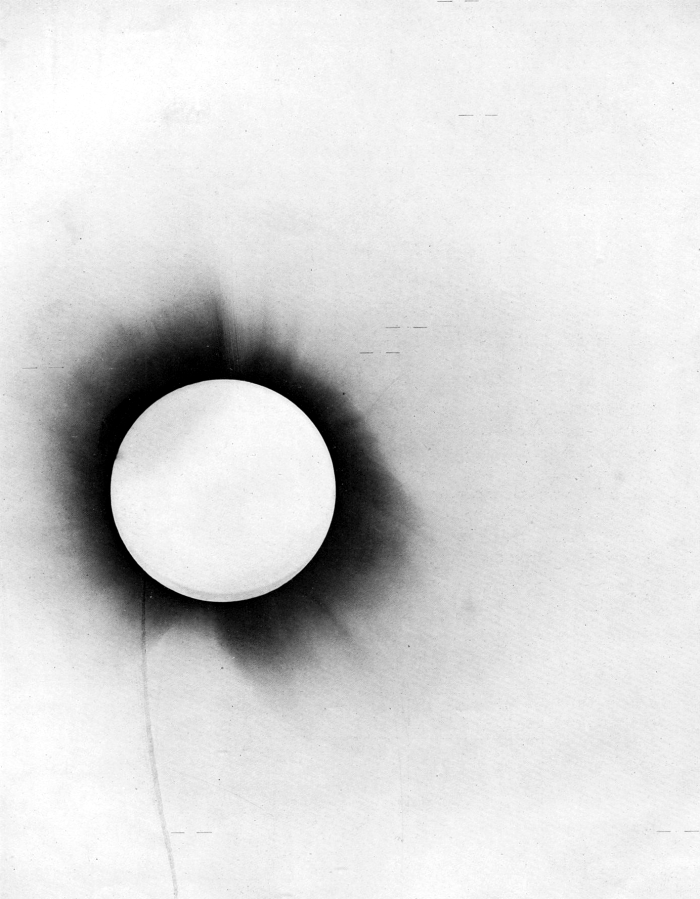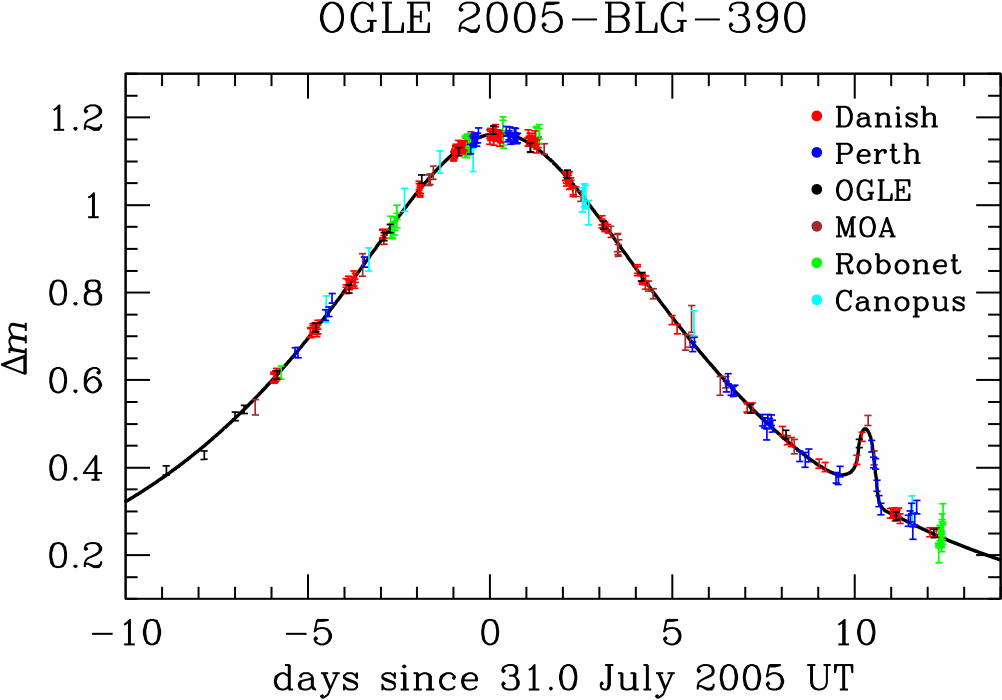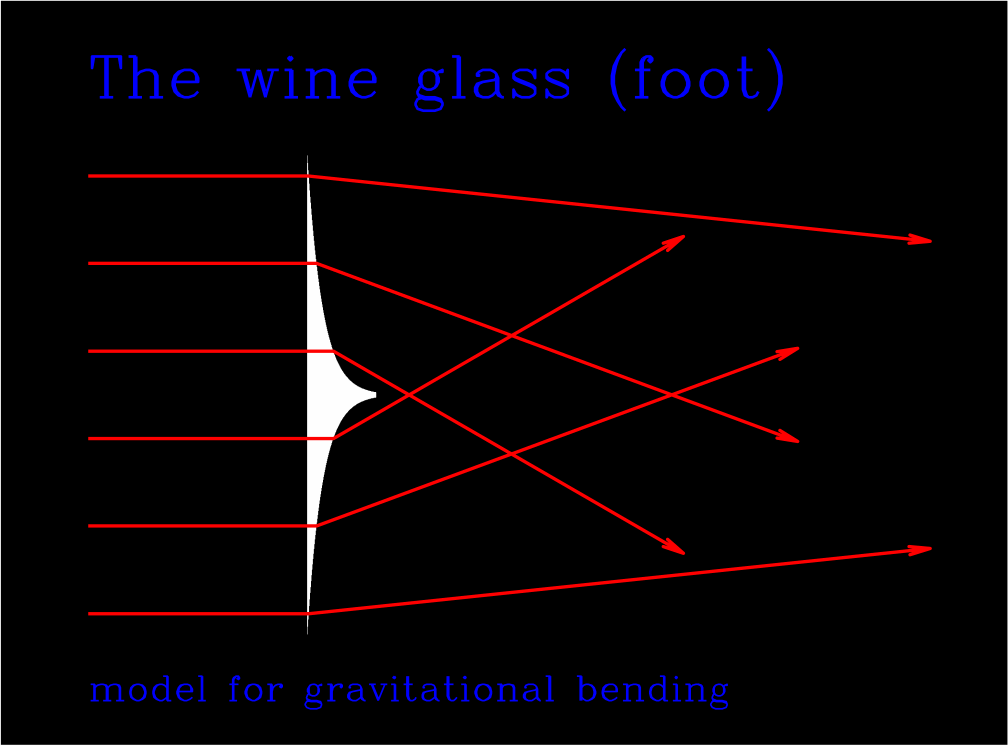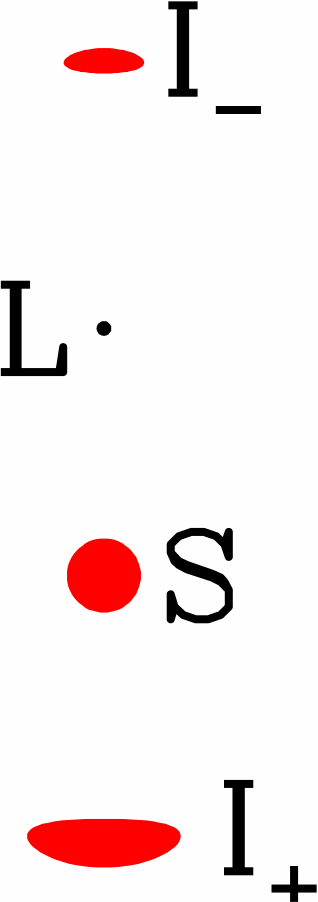Gravitational Microlensing – free from formulae

Albert Einstein in 1912
© The Albert Einstein Archives, The Jewish National & University Library
|
Even before Albert Einstein derived the theory of General Relativity, namely in 1911, he already concluded that massive bodies should bend light, and suggested to measure this deflection from the determination of the apparent position of
stars near the Solar limb during a
Solar eclipse. However, a treatment with the full equations of General Relativity in 1916 actually yielded a deflection angle that was twice as large as the one predicted earlier.
Two British expeditions set off to Sobral (Brazil) and the Island of
Principe to measure
the deflection angle during totality of the Solar Eclipse of 29 May 1919,
the latter being led by the (later knighted)
Arthur Eddington. These measurements confirmed the value predicted by Einstein's theory, which was met with a lot of scepticism before
– but not after.
In 1912, Einstein found that the gravitational bending of light could
lead to a transient brightening of an observed star as another star
happens to pass close to its line-of-sight. However, an angular
alignment sufficient for a significant effect is only expected in about
one in a million observed stars at any given time. Einstein therefore was himself sceptical about the prospects of
detecting such gravitational microlensing events, which
typically last a month. Therefore, it needed intense persuasion by others before he eventually published
his results in 1936, concluding that "there is no great chance of
observing this phenomenon".
|
|
Negative of one of the photographic plates taken by the British expedition
to Sobral (Brazil) during the total Solar Eclipse of 29 May 1919
© The Royal Society
|

|
|
|

(Sir) Arthur Stanley Eddington
|
|
The gravitational bending of light differs significantly from the effect
caused by an optical convex lens. With the deflection angle
vanishing for a light ray passing through the lens centre and increasing
towards its limb, a convex lens lets parallel light rays meet in a
focus.
In contrast, the light bending by a massive object is analogous to
the deflection by a glass body in the shape of the foot of a
wine glass.
Here, the deflection angle increases the closer the light ray
approaches the centre, representing the location of the gravitating
body.
Deflection of parallel light rays by a convex lens and by the foot of
the wine glass, which represents an analogy to the gravitational bending
of light. With the deflection decreasing towards its centre, the
convex lens leads to a focussing. A different behaviour results for
the light bending by massive bodies, where the deflection angle increases
the closer the light ray approaches.
The apparent brightening of the observed star is therefore not
the result of light rays being focussed onto the observer (on Earth).
Instead, the variation of the deflection angle with the massive
foreground 'lens' star determines a distortion of the light bundle
that results in an alteration of the solid angle from which the light
is received. More precisely, light reaches the observer along two
different paths, on either side of the lens star. Therefore, there
are two images of the source star at slightly different positions.
However, their angular separation is less than a milli-arcsecond, so that the
images cannot be resolved and only their combined magnification is
observable.
Side view (left) and observer's view (right) on a source star (S) affected
by gravitational microlensing due to a foreground lens star (L), where
two possible light paths to the observer (O) correspond to two apparent images I- and
I+.
In 1936, it was impossible – even for Albert Einstein – to imagine the data-processing rate possible with modern
computers and
digital cameras, and in fact, it required many decades of advance in technology
before the first detection of a microlensing event could be announced
in 1993, which required daily monitoring of the brightness of tens
of millions of stars. These efforts followed the suggestion by
Bohdan Paczynski to study
clumps of unknown 'missing' matter in the
Milky Way by means of the statistics of gravitational microlensing signals that these cause. In 1991, Shude Mao (then a student of Paczynski at Princeton
and now a professor at the University of Manchester) discovered that
planets orbiting the foreground 'lens' star could reveal their existence
by causing a small blip or dip to the othewise symmetric light curve.
Depending on the mass of the planet, such planetary 'anomalies' last between hours and days. Several planets having meanwhile been detected
from microlensing observations. The most spectacular discovery was
that of
OGLE-2005-BLG-390Lb, with a mass of just 5 times that of the Earth
the most Earth-like planet orbiting a star other than the
Sun at the time of its discovery (announced January 2006).
|
|

Model light curve and data (colour-coded) from 6 different observing
sites for the microlensing event OGLE-2005-BLG-390, whose lens star
hosts the 5-Earth-mass planet OGLE-2005-BLG-390Lb. The planet revealed its
existence by causing a blip of roughly 20% amplitude, lasting about a day,
on and around 10 August 2005. The vertical axis refers to the brightening in astronomical magnitudes with respect to the intrinsic luminosity
of the observed source star.
|
|

Artist's impression of the cool ice planet OGLE-2005-BLG-390Lb
by Herbert Zodet, © ESO
|
|
The software provided by ARTEMiS allows to adopt an
efficient strategy that enables current microlensing campaigns not
only to detect planets of Earth mass, but even below.
back
Martin Dominik, 13 December 2007








